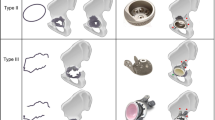Abstract
In a prospective and randomised clinical study, acetabular cups were implanted free-hand (control group n=22) or with computer assistance using an image-free navigation system (study group n=23). The cup position was determined postoperatively on pelvic CT. An average inclination of 42.3° (range: 30°–53°; SD±7.0°) and an average anteversion of 24.0° (range: −3° to 51°; SD±15.0°) were found in the control group, and an average inclination of 45.0° (ranage: 40°–50°; SD±2.8°) and an average anteversion of 14.4° (range: 5°–25°; SS±5.0°) in the computer-assisted study group. The deviations from the desired cup position (45° inclination, 15° anteversion) were significantly lower in the computer-assisted study group (p<0.001 each). While only 11/22 of the cups in the control group were within the Lewinnek safe zone, 21/23 of the cups in the study group were placed in this target region (p=0.003).
Résumé
Dans un étude clinique prospective et randomisé, les cupules acétabulaires ont été implantées de façon habituelle (n=22; groupe témoin) ou avec assistance d’un ordinateur qui utilise un système de navigation image—libre (n=23; groupe d’étude). La place de la cupule a été déterminée après l’opération sur un scanner pelvien. Une inclinaison moyenne de 42,3° (30° à 53°; ±7.0°) et une antéversion moyenne de 24,0° (−3° à 51°; ±15.0°) ont été trouvées dans le groupe témoin et une inclinaison moyenne de 45,0° (40° à 50°; ±2.8°) et une antéversion moyenne de 14,4° (5° à 25°; ±5.0°) dans le groupe de l’étude assistée par ordinateur. Les déviations par rapport à la position désirée de la cupule (45° d’inclinaison, 15° d’antéversion) étaient notablement inférieures dans le groupe de l’étude assistée par ordinateur (p<0.001 chacun). Alors que seulement 11 des 22 cupules du groupe témoin étaient dans la zone sûre de Lewinnek, 21 des 23 cupules du groupe d’étude ont été placées dans cette région cible (p=0.003).


Similar content being viewed by others
References
D’Lima DD, Urquhart AG, Buehler KO, Walker RH, Colwell CW Jr (2000) The effect of the orientation of the acetabular and femoral components on the range of motion of the hip at different head-neck ratios. J Bone Joint Surg Am 82:315–321
Del Schutte H Jr, Lipman AJ, Bannar SM, Livermore JT, Ilstrup D, Morrey BF (1998) Effects of acetabular abduction on cup wear rates in total hip arthroplasty. J Arthroplast 13:621–626
DeWal H, Su E, DiCesare PE (2003) Instability following total hip arthroplasty. Am J Orthop 32:377–382
DiGioia AM, Jaramaz B, Blackwell M, Simon DA, Morgan F, Moody JE, Nikou C, Colgan BD, Aston CA, Labarca RS, Kischell E, Kanade T (1998) The Otto Aufranc Award. Image-guided navigation system to measure intraoperatively acetabular implant alignment. Clin Orthop 355:8–22
Hassan DM, Johnston GH, Dust WN, Watson G, Dolovich AT (1998) Accuracy of intraoperative assessment of acetabular prosthesis placement. J Arthroplast 13:80–84
Jaramaz B, DiGioia AM III, Blackwell M, Nikou C (1998) Computer assisted measurement of cup placement in total hip replacement. Clin Orthop 354:70–81
Jolles BM, Genoud P, Hoffmeyer P (2004) Computer-assisted cup placement techniques in total hip arthroplasty improve accuracy of placement. Clin Orthop 426:174–179
Jolles BM, Zangger P, Leyvraz PF (2002) Factors predisposing to dislocation after primary arthroplasty: a multivariate analysis. J Arthroplast 17:282–288
Kalteis T, Beckmann J, Herold T, Zysk S, Bäthis H, Perlick L, Grifka J (2004) Accuracy of an image-free cup navigation system—an anatomical study. Biomed Tech 49:257–262
Kennedy JG, Rogers WB, Soffe KE, Sullivan RJ, Griffen DG, Sheehan LJ (1998) Effect of acetabular component orientation on recurrent dislocation, pelvic osteolysis, polyethylene wear, and component migration. J Arthroplast 13:530–534
Kummer FJ, Shah S, Iyer S, DiCesare PE (1999) The effect of acetabular cup orientations on limiting hip rotation. J Arthroplast 14:509–513
Leenders T, Vandevelde D, Mahieu G, Nuyts R (2002) Reduction in variability of acetabular cup abduction using computer-assisted surgery: a prospective and randomized study. Comput Aided Surg 7:99–106
Lewinnek GE, Lewis JL, Tarr R, Compere CL, Zimmerman JR (1978) Dislocations after total hip replacement arthroplasties. J Bone Joint Surg Am 60:217–220
McCollum DE, Gray WJ (1990) Dislocation after total hip arthroplasty: causes and prevention. Clin Orthop 261:159–170
Murray DW (1993) The definition and measurement of acetabular orientation. J Bone Joint Surg Br 75:228–232
Nogler M, Kessler O, Prassl A, Donnelly B, Streicher R, Sledge JB, Krismer M (2004) Reduced variability of acetabular cup positioning with use of an imageless navigation system. Clin Orthop 426:159–163
Paterno SA, Lachiewicz PF, Kelley SS (1997) The influence of patient-related factors and the position of the acetabular component on the rate of dislocation after total hip replacement. J Bone Joint Surg Am 79:1202–1210
Saxler G, Marx A, Vandevelde D, Langlotz U, Tannast M, Wiese M, Michaelis U, Kemper G, Grützner PA, Steffen R, von Knoch M, Holland-Letz T, Bernsmann K (2004) The accuracy of free-hand cup positioning—a CT based measurement of cup placement in 105 total hip arthroplasties. Int Orthop 28:198–201
Wentzensen A, Zheng G, Vock B, Langlotz U, Korber J, Nolte L-P, Grützner PA (2003) Image-based hip navigation. Int Orthop 27 (Suppl 1):S43–S46
Zheng G, Marx A, Langlotz U, Widmer KH, Buttaro M, Nolte LP (2002) A hybrid CT-free navigation system for total hip arthroplasty. Comput Aided Surg 7:129–145
Author information
Authors and Affiliations
Corresponding author
Rights and permissions
About this article
Cite this article
Kalteis, T., Handel, M., Herold, T. et al. Greater accuracy in positioning of the acetabular cup by using an image-free navigation system. International Orthopaedics (SICOT) 29, 272–276 (2005). https://doi.org/10.1007/s00264-005-0671-5
Received:
Accepted:
Published:
Issue Date:
DOI: https://doi.org/10.1007/s00264-005-0671-5




